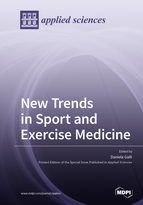New Trends in Sport and Exercise Medicine
A special issue of Applied Sciences (ISSN 2076-3417). This special issue belongs to the section "Applied Biosciences and Bioengineering".
Deadline for manuscript submissions: closed (30 April 2021) | Viewed by 92055
Special Issue Editor
Interests: sport medicine; physical activity; training; skeletal and cardiac muscle biology
Special Issues, Collections and Topics in MDPI journals
Special Issue Information
Dear Colleagues,
In the last twenty years it has been shown that the practice of regular physical activity reduces the risks of chronic diseases such as cardiovascular diseases, diabetes, and depression, but it has been also demonstrated that it reduces the incidence of colon and breast cancer. Moreover, physical exercise is fundamental in weight control and energy expenditure to contrast the increase of obesity. For example, different training modalities (i.e., aerobic, resistance, concentric, and eccentric) have been shown to influence adipokines and atherosclerosis markers.
On the other side, sport and physical activity are determinants in several disciplines, from wellness and public health to physiotherapy. It also aims to prevent injuries. Thus, advances in sport and exercise medicine could be of high clinical relevance for general sport practitioners, physicians, and athletes. Sport nutrition may also have wider implications.
In this Special Issue, we look for original manuscripts and reviews to cover novel insights in sport and exercise medicine.
Dr. Daniela Galli
Guest Editor
Manuscript Submission Information
Manuscripts should be submitted online at www.mdpi.com by registering and logging in to this website. Once you are registered, click here to go to the submission form. Manuscripts can be submitted until the deadline. All submissions that pass pre-check are peer-reviewed. Accepted papers will be published continuously in the journal (as soon as accepted) and will be listed together on the special issue website. Research articles, review articles as well as short communications are invited. For planned papers, a title and short abstract (about 100 words) can be sent to the Editorial Office for announcement on this website.
Submitted manuscripts should not have been published previously, nor be under consideration for publication elsewhere (except conference proceedings papers). All manuscripts are thoroughly refereed through a single-blind peer-review process. A guide for authors and other relevant information for submission of manuscripts is available on the Instructions for Authors page. Applied Sciences is an international peer-reviewed open access semimonthly journal published by MDPI.
Please visit the Instructions for Authors page before submitting a manuscript. The Article Processing Charge (APC) for publication in this open access journal is 2400 CHF (Swiss Francs). Submitted papers should be well formatted and use good English. Authors may use MDPI's English editing service prior to publication or during author revisions.
Keywords
- Physical activity
- Sport
- Nutrition
- Training
- Chronic diseases
- Molecular markers
- Anti-oxidants
- Medicine
- Skeletal muscle
- Cardiac muscle
Benefits of Publishing in a Special Issue
- Ease of navigation: Grouping papers by topic helps scholars navigate broad scope journals more efficiently.
- Greater discoverability: Special Issues support the reach and impact of scientific research. Articles in Special Issues are more discoverable and cited more frequently.
- Expansion of research network: Special Issues facilitate connections among authors, fostering scientific collaborations.
- External promotion: Articles in Special Issues are often promoted through the journal's social media, increasing their visibility.
- Reprint: MDPI Books provides the opportunity to republish successful Special Issues in book format, both online and in print.
Further information on MDPI's Special Issue policies can be found here.






